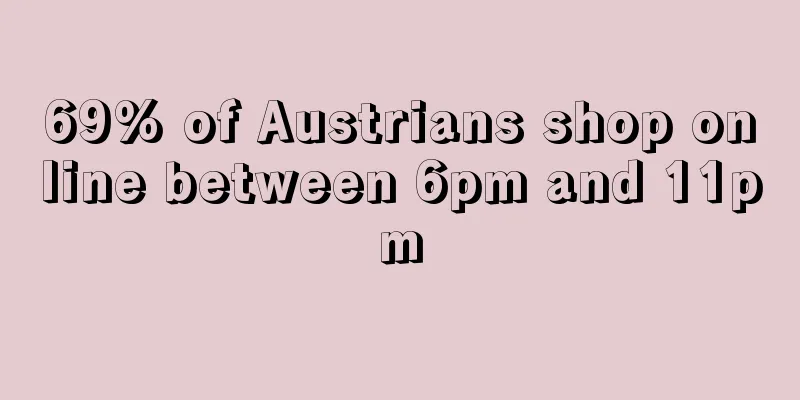69% of Austrians shop online between 6pm and 11pm

|
According to a recent study by KPMG, half of Austrians have changed their previous shopping habits after the outbreak of the COVID-19 pandemic. To further study the trends and potential of e-commerce, the research project surveyed 3,100 consumers in DACH , including more than 1,000 from Austria.
The results show that there are many reasons for the changes in consumer purchasing behavior in Austria, Germany and Switzerland . Less than 40% of DACH respondents said that they participated in more online shopping because they wanted to minimize the frequency of contact with the outside world. More than 33% of respondents said that the health measures taken during the epidemic reduced their shopping interest . In addition, 25% of respondents believed that the change in consumption patterns was a trend of the times rather than out of their own needs .
In order to understand the consumer behavior habits of different age groups, KPMG divided the respondents into four age groups : Generation Z (18-24 years old), Millennials (25-39 years old), Generation X (40-55 years old) and Baby Boomers (56-89 years old) , among which Generation Z and Millennials are the majority.
Research shows that 33% of Austrian Gen Z say that 60% of the items they need in life are purchased online. This proportion is quite low compared to neighboring Germany, where the proportion of Gen Z people who purchase more than 60% of their items online reaches 56% .
The proportion of Austrian millennials who like online shopping is just as high as that of Generation Z , and more than 50% of millennial respondents said they like to use apps for online shopping.
The survey shows that in recent months , the product category that Austrian consumers bought online for the first time was food, followed by fashion and home furnishings. Only 30% of Generation Z have tried shopping on fresh food e-commerce platforms .
In addition, online shopping takes very little time compared to shopping in physical stores . Two-thirds of orders are completed within 20 minutes. 50% of Austrians buy online several times a month, and 14% even several times a week.
69% of Austrian respondents said they often shop between 6pm and 11pm and have no particular preference for which day of the week to shop online . Based on this, Austrian merchants can adjust the time of advertising to increase advertising conversion rates.
77% of Austrian consumers will abandon their orders if the shipping costs are too high , while in Germany and Switzerland, this proportion is only 66%. In response to the high abandonment rate caused by high shipping costs, merchants can adjust the shipping prices on their own to increase the number of orders.
Additionally, around 50% of Austrian respondents said they would not shop at an online store that did not offer their preferred payment method or if delivery took too long . Austria Consumption habits Online shopping |
<<: Elevate Brands raises $67.5 million, plans to acquire 100 Amazon brands by next year
>>: Paton's business changes, Xiaomi and SHEIN join the game
Recommend
What is Doordash? Doordash Review, Features
DoorDash was founded in July 2013 and is headquar...
Attention! AliExpress releases annual sales assessment criteria for sellers
Recently, the official website of AliExpress rele...
What is Eight Sleep? Eight Sleep Review, Features
Founded in 2014, Eight Sleep is a sleep health co...
Indian social e-commerce platform DealShare receives $100 million in Series D funding
Having just completed its previous US$21 million ...
What is Bindwise? Bindwise Review, Features
Bindwise is an EU-based software startup that offe...
Online sales increased by 98.1%! TCS in the United States achieved record-breaking development
TCS ( The Container Stores ), headquartered in Te...
Low prices are the most likely to trigger European consumers’ desire to buy new brands
According to statistics, there are two factors th...
Traffic warning! The latest hot-selling trends in Europe and America are freshly released
Clothing is a popular category for overseas sales...
Amazon's 2021 Prime Day sales totaled $11.19 billion; starting in July, goods without IOSS will be detained by customs
Amazon's 2021 Prime Day sales totaled $11.19 ...
With 400,000 orders per month and a profit of 7,000 yuan, Temu sellers are trying to overwhelm their peers
Behind Temu's low-price market share, it is u...
Amazon urgently removed such products from shelves, and Made in China was blamed again
However, the United States is only a microcosm of...
What is Fordeal? Fordeal Review, Features
Fordeal is a practitioner of China's manufact...
A new type of "account blocking behavior"? A group of sellers were caught
Troubled times! Every peak season will see a larg...
What is Amazon's new UPNEP plan? Amazon's new UPNEP plan Review, Features
Amazon's new UPNEP program is another powerful...
A container ship caught fire! It was loaded with Chinese goods and had been docked in Shenzhen and other places...
Breaking news! A container ship full of Chinese g...









